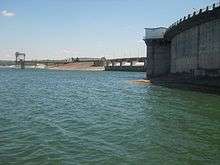Stânca-Costești Dam
The Stânca-Costeşti Dam (Romanian: Barajul Stânca-Costeşti) is a dam on the Prut and a checkpoint between Moldova and Romania. The dam is located between Costeşti (Moldova) and Stânca (Romania).
| Stânca-Costeşti Dam | |
|---|---|
 | |
 Location of Stânca-Costeşti Dam in Moldova | |
| Official name | Barajul Stânca-Costeşti |
| Location | Costeşti (Moldova) / Stânca (Romania) |
| Coordinates | 47°51′30″N 27°15′31″E |
| Construction began | 1974 |
| Opening date | 5 November 1978 |
| Owner(s) | C.N. Apele Române S.A. |
| Dam and spillways | |
| Impounds | Prut |
| Height | 43 m (141 ft) |
| Length | 300 m (980 ft)[1] |
| Reservoir | |
| Creates | Stânca-Costeşti Lake |
| Total capacity | 1.29 km3 (1,050,000 acre⋅ft) |
| Catchment area | 12,000 km2 (4,600 sq mi) |
| Surface area | 77 km2 (30 sq mi) |
History
The basic Romanian-Soviet agreement on its construction was ratified in 1972. Built between 1974–1978, the Stânca Costeşti Lake is a USSR-Romanian project. The lake is the reservoir for a hydro power station. The main goal of building this power station was to protect villages down the Prut river from annual floods. The 1970 floods in Romania were the worst in modern Romanian history in loss of life.
On 5 November 1978 the Stânca-Costeşti Hydroelectrical Plant on the Prut was inaugurated. Romania was represented by Ion Iliescu, the then-Minister of Electric Power Trandafir Cocîrlă, and Chairman Florin Iorgulescu of the Romanian National Council for Water Conservation, while Ivan Bodiul, Minister of Power and Electrification Peter Stepanovich Neporozhny, and Deputy Minister of Land Reclamation and Water Conservation Polat Zade represented the USSR.[2]